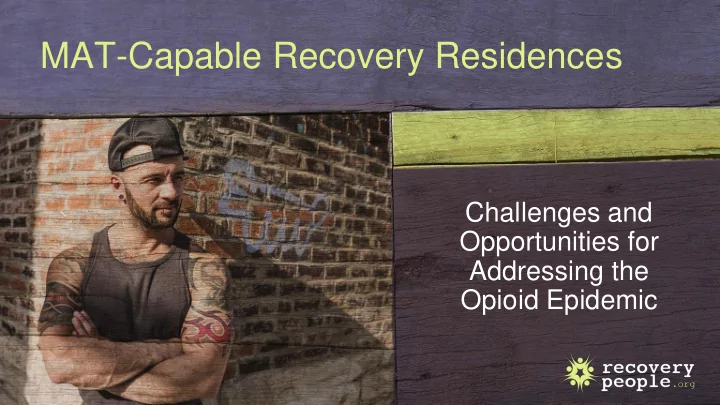

MAT-Capable Recovery Residences Challenges and Opportunities for Addressing the Opioid Epidemic
NARR Levels of Support
NARR Levels of Support
Bridging the Gap Medication Abstinence- Medication Assisted based Assisted Treatment recovery Recovery
Not all recovery residences are Willing, Willing, unable capable proficient at supporting persons on MAT Unwilling, Unwilling, unable capable
Knowledge Challenge Lack of: ➔ Research ➔ Practice based evidence / best practices ➔ Lived experience
Knowledge Solution Support: ➔ Pilot studies ➔ Communities of Practices ➔ Training / technical assistance ➔ Lived experience / Medication Assisted Recovery (MAR) peer leadership development
Culture Clash Challenge Recovery residence reflects the culture of the local communities that support them: ➔ Predominantly 12 Step & Faith-based ➔ Historically not support opioid agonist treatment Early study report negative attitudes amongst residents.
MAR Culture Solution Medication Assisted Recovery: ➔ Belief systems ➔ Traditions, celebrations ➔ Leaders, champions, mentors ➔ Literature, art, memes ➔ Psychological sense of community Educate greater recovery community ➔ Success stories, recovery outcomes ➔ To a lesser degree, research
Diversion Risk Challenge ➔ Full and partial agonist medications are prone to diversion ➔ In a recovery residence, diversion, dependence and the addictive qualities of full or partial-agonist medications are a serious concern ➔ Some of the strongest opponents of opioid agonist treatment are those who have had negative experiences on MAT, including addiction
Diversion Management Solution Substance Abuse and Mental Health Services Administration guidelines suggest ➔ Diversion risk of both full and partial agonist therapies increases when these medications are taken at home or off-site ➔ Lower risk for diversion when administered in settings where direct observation of medications occurs. What if the recovery residence does not have the capacity to do so?
Staffing Capacity Challenge ➔ Most lack staff to monitor administration of medications ➔ Staff may have OUD and/or negative experience with MAT
Staffing Capacity Solutions Some higher levels, may be better suited for such monitoring.
Uncoordinated Care Challenge Medical healthcare systems do not have a history of working with recovery residence providers to deliver comprehensive, coordinated care. “ (N)ot all prescribers want to be in dialogue with (recovery residence providers)… our hope is that the longer we’re doing this the more they see us as partners …”.
Coordinated Care Solution ➔ Early MAT recovery housing pilots indicate that the relationship and communication with the prescribers is key ➔ Resources should be allocated to support greater coordination of care between prescribers and recovery support service providers, such as recovery residences
16
Recommend
More recommend